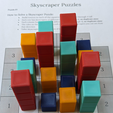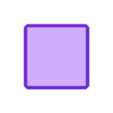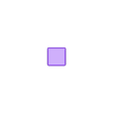3D model description
Skyscrapers Puzzle Game Pieces
This is a set of pieces for playing the "Skyscrapers" game of spatial reasoning, also sometimes called "Towers".
Rules of Play
The rules somewhat resemble sudoku. Place n² pieces, n each of of n different heights, from 1 unit to n units, on an n x n grid, following a few simple rules:
- Each row contains only one piece of each height.
- Each column contains only one piece of each height.
- A number in a square means a piece of that unit height must be placed there.
- A number next to the grid means that you must be able to "see" only that number of pieces from that location outside the grid; that is, that exactly that number of pieces must be placed in ascending order by height away from that edge in the adjacent row or column, and that no taller pieces are placed further away from the number. Note that the visible pieces might not be immediately adjacent; there may be shorter pieces hidden in between.
A proper Skyscrapers puzzle has a unique solution.
In general, like sudoku, simple Skyscraper puzzles have many of these placement constraints expressed, such that they are redundant. In simple games, the number of "visible" towers might be specified at every station along each row or columns. More challenging puzzles have fewer redundant constraints.
Most published printable grids use a 1" (25.4mm) spacing, which are often played with 3/4" (19.05mm) locking unifix "cubes". This leaves some room for manipulating the pieces while solving the puzzle. This set uses 20mm unit size, which is also playable on those common
grids.
You can also try this puzzle online.
Customization
The FreeCAD source for these blocks is included. There is a spreadsheet called p (for parameters) that contains parameters you can change, if you want.
The side parameter allows you to choose a unit size; the default is 20mm
The thickness parameter sets the wall thickness where there is no chamfer; the default is 1.5mm
The chamfer parameter sets the normal depth of the chamfer; the default is 1mm, and it must be smaller than the thickness by at least one reasonable filament line width.
The clearance parameter sets the distance between the different height models for viewing purposes.
Changes
- 29 March 2024: Added internal chamfers at unit marks to increase strength; two of the hundreds I have made broke at the unit lines in play.
3D printing settings
The *n*Unit blocks, which are provided for one to six units in height, are printable without supports.
If you print the STEP files, they are hollow inside and are intended to be self-supporting using a "cascading diamond" internal feature that works with layer thickness 0.3mm or thinner. No generated infill is required.
If you print the STL files, be aware that due to a characteristic of how FreeCAD exports the STLs, the slicer may not recognize the internal void. In that case, you may need either to enable some infill (if you have bridging failures supporting the top of the block), or in PrusaSlicer and its derivatives, there is a Print Settings → Advanced → Slicing → Slicing Mode that can be changed from "Regular" to "Even-odd", which will enable it to print the internal voids correctly.
The game will be easier to play if each size is printed in its own color. All the 1Unit blocks in one color, all the 2Unit in another color, and so forth.
For any particular grid size, you will need to print at least that many pieces of each size. To do a 4x4 grid, you will need 4 1Unit, 4 2Unit, 4 3Unit, and 4 4Unit pieces. To do a 5x5 grid, you will need 5 1Unit, 5 2Unit, 5 3Unit, 5 4Unit, and 5 5Unit pieces.

/https://fbi.cults3d.com/uploaders/14535803/illustration-file/67b1beee-fff9-44a3-a158-0673909fd62f/Screenshot-from-2023-09-24-13-13-39.png)









